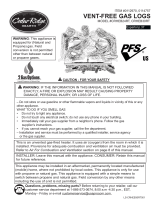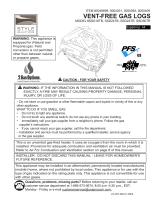
5
Your vent-free gas burner system SHALL NOT BE INSTALLED IN A CONFINED SPACE or unusually tight
construction unless provisions are made for adequate combustion and ventilation air.
• The National Fuel Gas Code, ANSI Z223.1/NFPA 54 defi nes a confi ned space as a space whose volume is less
than 50 cu. ft. per 1,000 BTU per hour (4.8 meters
3
per kw) of the aggregate input rating of all appliances installed
in that space.
• An unconfi ned space is a space where volume is at least 50 cu. ft. per 1,000 BTU per hour (4.8 meters
3
per kw)
of the aggregate input rating of all appliances installed in that space.
• Rooms communicating directly with the space in which the appliances are installed, through openings not furnished
with doors, are considered a part of the unconfi ned space.
(Length x Width x Height x 20 = Maximum BTUs allowed)
Example: To install a Peterson Real-Fyre
®
vent-free gas
burner system with 36,000 BTU, maximum, in a space
with no other gas-burning appliances, the space MUST be
1,800 cu. ft. or larger.
Assuming an 8' ceiling, fl oor dimensions must be a minimum
of 225 sq. ft.,
i.e.; 18'x12.5'=225 sq ft (see Fig. 5-1).
VENTILATION AND CONFINED SPACE SAFETY INFORMATION
L x W x H x 20 = Maximum BTU allowed
WARNING
If the area in which the heater may be operated is
smaller than that defi ned as an unconfi ned space or if
the building is of unusually tight construction, provide
adequate combustion and ventilation air by one of the
methods described in the National Fuel Gas Code, ANSI
Z223.1/NFPA 54, Air for Combustion and Ventilation, or
applicable local codes.
REMEMBER
L x W x H x 20 = MAXIMUM BTUs ALLOWED
If the space is smaller than the above formula allows,
and/or smaller than the examples and diagrams on
this page specify, DO NOT install the vent-free burner
system unless provisions for additional combustion
and ventilation air are made.
WARNING: Do not install the unvented burner system
where the room is considered a confined
space (see Fig. 5-1).
To determine if the area where this burner system is to be
installed fi ts the defi nition of an unconfi ned space, multiply
the length of the room by the width of the room by the height
of the room, then multiply by 20. The result is the maximum
BTU allowed.
Fig. 5-1
IT MAY BE NECESSARY TO OPEN A WINDOW
SLIGHTLY (1"- 2") OR OTHERWISE INCREASE
VENTILATION. CONDITIONS REQUIRING THIS
INCLUDE, BUT ARE NOT LIMITED TO:
1. Installation in a CONFINED SPACE.
2. Installation in a HOME OF UNUSUALLY
TIGHT CONSTRUCTION**.
3. Installation at HIGH ALTITUDES.
4. Certain MEDICAL OR PHYSICAL
CONDITIONS OF THE HOMEOWNER that
may be adversely impacted by combustion
products created by burning natural or
propane gas.
Installation in a tightly constructed home and/
or installation at high altitudes may cause your
vent-free burner system to produce excessive heat or
excessive moisture. The oxygen depletion sensor may
shut down the burner system. These conditions may be
corrected by opening a window or otherwise increasing
the number of air changes in the home.
**
Unusually tight construction is defi ned as construction where:
a. Walls and ceilings exposed to the outside atmosphere have a
continuous water vapor retarder with a rating of 1 perm (6x10
-
11
kg
per pa-sec-m
2
), or less with openings gasketed or sealed;
b. Weather stripping has been added on openable windows and
doors, and
c. Caulking or sealants are applied to areas such as joints around
window and door frames, between sole plates and fl oors, between
wall-ceiling joints, between wall panels, at penetrations for plumbing,
electrical, and gas lines, and at other openings.
The Peterson Real-Fyre
®
vent-free burner system
has been certifi ed to function safely and reliably with
emission by-products well within accepted safety and
health standards. Your specifi c medical or physical
condition may render you more sensitive to products
created by burning natural or propane gas. If this is the
case, you should open a window or otherwise increase
ventilation.





















